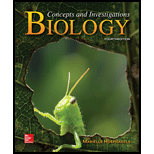
Concept explainers
A
a. sugar.
b. nitrogen-containing group.
c. sulfur-containing group.
d. phosphorus-containing group.
Introduction:
Nucleotides are defines as the organic molecules which serves as the building block of nucleic acid. It consists of phosphate group, pentose sugar and nitrogenous base. There are two types of nucleic acid such as ribonucleic acid and deoxyribonucleic acid. These are essential biomolecules responsible for forming all living forms on earth.
Answer to Problem 1MCQ
Correct answer:
The nucleotide is composed of phosphate group, pentose sugar and nitrogenous bases. Therefore, option (c) is correct.
Explanation of Solution
Reason for the correct statement
A nucleotide is organic molecule which is formed by phosphate group, pentose sugar and nitrogenous bases. There are two types of nitrogenous bases such as pyrimidine and purine bases. It also contain phosphate group. Deoxyribonucleic acid and Ribonucleic acid is formed by nucleotide. The only difference between in these two nucleic acid is presence of deoxyribose and ribose sugar as well as in RNA uracil is bonded with thymine while in DNA cytosine is bonded with thymine.
Option (c) is given as “sulfur-containing group”.
As, “Sulfur containing group is not found in nucleotide as it contains nitrogenous bases, phosphate group and sugar”, is the right answer.
Hence, option (c) is correct.
Reasons for the incorrect statements:
Option (a), is given as “sugar”.
There are two types of sugar is present in nucleotide as in RNA ribose sugar is present while in DNA deoxyribose sugar is present. Hence, it is a wrong answer.
Option (b), is given as “nitrogen-containing group”
Nitrogen-containing group are the nitrogenous bases which is of two types such as pyrimidine and purine. Hence, it is a wrong answer.
Option (d), is given as “phosphate-containing group”.
Nucleotide is formed by phosphate- sugar backbone along with that purine and pyrimidine bases are joined together by hydrogen bonds. Hence, it is a wrong answer.
Hence, options (a), (b), and (d), are incorrect.
Nucleotide is formed of sugar, phosphate group and nitrogenous bases and it do not contain sulfur containing group.
Want to see more full solutions like this?
Chapter 7 Solutions
Biology: Concepts and Investigations
Additional Science Textbook Solutions
Anatomy & Physiology
Biological Science
Human Anatomy
Becker's World of the Cell (9th Edition)
Human Physiology: An Integrated Approach (8th Edition)
Campbell Biology: Concepts & Connections (9th Edition)
- Draw and label the dinucleotide AT as follows: A. 5’ and 3’ ends B. Phosphodiester bond C. N-glycosidic bondsarrow_forwardWhich of the following is not related to the other four? a. phosphate groups b. nucleotides c. amino acids d. nitrogenous bases e. five-carbon sugarsarrow_forwardname the The components of a nucleotidearrow_forward
- Describe the three components of a nucleotidearrow_forwardClassify each of the following amino acid as polar or nonpolar. If polar, indicate if the R group is neutral, acidic, it basic. Indicate if each is hydrophobic or hydrophilic. a. lysine b. arginine c. methionine d. tyrosinearrow_forwardWhat are the three main parts of a nucleotide?arrow_forward
- A nucleotide contains which of the following?a. 5-carbon sugar b. nitrogen base c. phosphate d. b and c only e. all of thesearrow_forwardThe variable structures of a nucleotide are the sugar and the phosphate group. (a). Say if the statement written above is true or false. (b). Give ONE reason for your answer in part (a).arrow_forwardWhich of the following are nitrogenous bases with the general structure shown in the picture? a.cytosine b.uracil c.thymine d.adenine e.guaninearrow_forward
- Below you will find the structures for nurine and pyrimidine. a. Label each structure with its name b. Name each of the associated nucleotides based on these molecules (differentiate between purines and pyrimidines) c. Give the one letter codes for each nucleotidearrow_forwardDraw the two dipeptides formed from each pair of amino acids. a. tyrosine and lysine b. threonine and glutamine c. alanine and histidinearrow_forwardWhich of the following statements about nucleotides is true? (Select all that applied) Select one: a. A nucleotide contains a phosphate group. b. All of these. c. A nucleotide contains a pentose. d. A nucleotide contains a nitrogenous base.arrow_forward
 Human Anatomy & Physiology (11th Edition)BiologyISBN:9780134580999Author:Elaine N. Marieb, Katja N. HoehnPublisher:PEARSON
Human Anatomy & Physiology (11th Edition)BiologyISBN:9780134580999Author:Elaine N. Marieb, Katja N. HoehnPublisher:PEARSON Biology 2eBiologyISBN:9781947172517Author:Matthew Douglas, Jung Choi, Mary Ann ClarkPublisher:OpenStax
Biology 2eBiologyISBN:9781947172517Author:Matthew Douglas, Jung Choi, Mary Ann ClarkPublisher:OpenStax Anatomy & PhysiologyBiologyISBN:9781259398629Author:McKinley, Michael P., O'loughlin, Valerie Dean, Bidle, Theresa StouterPublisher:Mcgraw Hill Education,
Anatomy & PhysiologyBiologyISBN:9781259398629Author:McKinley, Michael P., O'loughlin, Valerie Dean, Bidle, Theresa StouterPublisher:Mcgraw Hill Education, Molecular Biology of the Cell (Sixth Edition)BiologyISBN:9780815344322Author:Bruce Alberts, Alexander D. Johnson, Julian Lewis, David Morgan, Martin Raff, Keith Roberts, Peter WalterPublisher:W. W. Norton & Company
Molecular Biology of the Cell (Sixth Edition)BiologyISBN:9780815344322Author:Bruce Alberts, Alexander D. Johnson, Julian Lewis, David Morgan, Martin Raff, Keith Roberts, Peter WalterPublisher:W. W. Norton & Company Laboratory Manual For Human Anatomy & PhysiologyBiologyISBN:9781260159363Author:Martin, Terry R., Prentice-craver, CynthiaPublisher:McGraw-Hill Publishing Co.
Laboratory Manual For Human Anatomy & PhysiologyBiologyISBN:9781260159363Author:Martin, Terry R., Prentice-craver, CynthiaPublisher:McGraw-Hill Publishing Co. Inquiry Into Life (16th Edition)BiologyISBN:9781260231700Author:Sylvia S. Mader, Michael WindelspechtPublisher:McGraw Hill Education
Inquiry Into Life (16th Edition)BiologyISBN:9781260231700Author:Sylvia S. Mader, Michael WindelspechtPublisher:McGraw Hill Education





